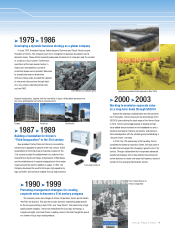Omron 2003 Annual Report Download - page 21
Download and view the complete annual report
Please find page 21 of the 2003 Omron annual report below. You can navigate through the pages in the report by either clicking on the pages listed below, or by using the keyword search tool below to find specific information within the annual report.
Topics
Activities to Reduce Environmental Impact
• Reduction of CO2Emissions from Energy Usage
To help prevent global warming, Omron sets targets each fiscal year for
reduction of carbon dioxide emissions, and takes steps to achieve them. In
the year ended March 31, 2003, the target for the total volume of CO2
emissions at domestic production sites was 45,239 tons-CO2, a 5 percent
reduction compared with the level in the year ended March 1996. The
actual result was an 11 percent reduction to 42,486 tons-CO2. Despite an
increase in production volume, CO2emissions per unit of production
improved 10 percent from the previous fiscal year due to higher
productivity and improved yield. At overseas production sites, the total
volume of CO2emissions was 30,236 tons-CO2.
• Wastes and Recycling
Omron’s targets for the year ended March 2003 were a recycling rate of
94.0 percent and a final disposal rate of 4.0 percent. Actual results were a
recycling rate of 95.1 percent and a final disposal rate of 2.0 percent. Total
waste volume was 3,882 tons, a 3 percent reduction from the previous
fiscal year, and the final disposal volume was 78 tons, a 60 percent
reduction. In the past fiscal year, ten more domestic production sites
achieved zero emissions, and 12 of the 15 sites have now done so.
Overseas, total waste volume was 2,964 tons.
• Reduction of Environmental Impact in Distribution
Omron took steps to reduce the environmental impact of its distribution
operations in the year ended March 2003. Measures included
implementing rail shipping from Kyushu to Nagoya, and from Kyushu to
Tokyo, as well as shortening shipping distances by changing distribution
routes. As a result, total CO2emissions were reduced 18.6 percent, or 828
tons-CO2, from the previous fiscal year. Omron also introduced a container
returnable system at 140 major domestic distributors, and consequently
reduced cardboard boxes for product packing by 30 percent (46.2 tons)
compared with the previous fiscal year.
Reduction of Regulated Chemical Substances
• Operation of Database for Regulated Chemical Substances
The content of regulated chemical substances in all major components
and materials purchased by the Company is registered in a database that
Omron began using in the year ended March 2003. In the future, Omron
will be able to use this database in product assessments at the
development and design stage to reduce the amount of regulated chemical
substances contained in products.
• Environmental Accounting
In the year ended March 2003, Omron adopted environmental accounting
at 9 domestic non-production sites, after introducing it for 15 domestic
production sites in the previous fiscal year. Results for domestic production
and non-production sites in the year ended March 2003 are as follows:
(1) Environmental protection cost: ¥2,190 million (investment ¥570
million, expenses ¥1,620 million)
(2) Economic benefits: ¥110 million (Actual benefits only, not including
intangible benefits)
(3) Quantitative benefits: CO2emissions reduced 1,796 tons (3.5%
reduction from previous fiscal year), volume of waste reduced 219 tons
(5% reduction from previous fiscal year)
Creation of Eco-Products
Omron has been promoting the creation of eco-products since it
established the ISO 14021-based “Eco-Product Approval System” in 1998.
In the year ended March 2003, 47 products were approved (26 Eco-
Products, 21 products with the Eco label), bringing the cumulative total to
119 products. Eco-products (including products approved for the Eco label)
accounted for 14 percent of all new products in the year ended March
2003. Omron will accelerate the creation of eco-products, aiming to raise
the eco-product ratio to 50 percent in the current fiscal year.
Green Procurement
• Purchasing Green Parts and Materials
Using green procurement standards, Omron conducted evaluations of
527 suppliers in the year ended March 2003, and certified 502 (95 percent)
of them as green suppliers. Purchases from green suppliers constitute 91
percent of Omron’s parts and material purchases. Omron plans to give
green suppliers preferential status in purchasing in the future.
• Purchasing Green Indirect Materials
An Indirect Materials Purchasing Management System has been
adopted and put into operation at Omron Group companies in Japan to
promote purchasing of green products and reduce costs. In the year ended
March 2003, the green product purchasing rate was 82 percent. Omron
plans to enhance this system by expanding its application to include office
equipment and office furniture.
Annual Report 2003 • 19
27,928
30,232
50,000
(t-CO2)
45,000
40,000
35,000
30,000
1995 1998 1999 2000 2001 2002
0
0
-9
-15
-18
-5
-14
0
(%)
(FY)
-10
-20
-30
-40
-50
Note: In addition to the above, CO2 emissions from 9 offices and laboratories totaled
9,218t-CO2 during the year ended March 31, 2003. In the year ended March 31, 2003,
the unit for CO2 emission volume was changed from tons-C to tons-CO2.
Total CO
2
Emissions from Omron Factories in Japan
Domestic sites (target)
Overseas sites (actual total)
Domestic sites (actual)
CO2 emissions-to-production unit ratio
45,577
47,601
46,589
42,742
46,252
45,320
45,914
48,807
44,022
45,239
42,486
47,601
























